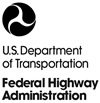 |
PDF Version, 997KB
PDF files can be viewed with the Acrobat® Reader®.
 |
Memorandum |
| Subject: | INFORMATION: MUTCD – Official Ruling No. 2(09)-111 (I) – International Symbol of Accessibility | Date: May 28, 2015 |
| From: | Jeffrey A. Lindley Associate Administrator for Operations |
In Reply Refer To: HOTO-1 |
| To: | Associate Administrators Chief Counsel Chief Financial Officer Directors of Field Services Director of Technical Services |
Purpose: Through this memorandum, the Federal Highway Administration's (FHWA) Office of Transportation Operations (HOTO) issues an Official Interpretation of the Manual on Uniform Traffic Control Devices for Streets and Highways (MUTCD) on the use of alternative designs for the International Symbol of Accessibility in traffic control device applications. For recordkeeping purposes, this Official Ruling has been assigned the following number and title: "2(09)-111 (I) – International Symbol of Accessibility."
Background: Requests are being made of State and local authorities to substitute the International Symbol of Accessibility with alternative, "dynamic" designs that have been developed by advocacy groups that constitute a fundamental design change to the International Symbol of Accessibility. One group has encouraged citizens to cover existing symbols on traffic signs and pavement markings with its alternative graphic and, in some cases, has used alternative colors to those prescribed in the MUTCD.
These alternative symbol designs have not been adopted or endorsed by the U. S. Access Board, which is responsible for promulgating Federal rules on accessibility and whose members include the U. S. Department of Justice and U. S. Department of Transportation. Additionally, the International Organization for Standardization, which established the official symbol, has stated that it does not support the alternative symbol design being promoted. The only symbols allowed for use in traffic control device applications are those adopted in the MUTCD or approved provisionally through the MUTCD official experimentation process.
The FHWA pursues improvements to traffic control devices on a continuing basis. However, such changes must undergo extensive human factors testing to ensure adequate levels of comprehension, recognition, and legibility for optimization in a roadway environment. The process by which a road user views a sign or other traffic control device differs greatly from an architectural function in which smaller signs or graphics are viewed by occupants of buildings from a close, stationary position. Further, the use of non conforming symbols—whether by approval of local authority or by actions of citizens who deface a traffic control device—compromises the enforceability of these devices.
The official design for the International Symbol of Accessibility for use in traffic control device applications is that which has been adopted by and is illustrated in the MUTCD and coincides with the design adopted by the Americans with Disabilities Act Accessibility Guidelines. Fabrication details can be found in the Standard Highway Signs publication.
Conclusion: Sections 2A.06, 2A.12, and 3B.20 of the MUTCD require that symbols used in traffic control device applications be "unmistakably similar" to the adopted symbols as depicted in the MUTCD and detailed in the Standard Highway Signs publication. It is the official interpretation of the FHWA that the alternative symbols being advocated do not meet this requirement and are not acceptable for use in traffic control device applications. The FHWA is receptive to reviewing information supporting the effectiveness of an alternative symbol design that demonstrates equivalent facilitation. However, consideration for implementation in traffic control device applications would depend upon favorable acceptance by and intent of the aforementioned stakeholder organizations to adopt a redesigned symbol for broad implementation.
Attachment
cc:
Mr. Scott Windley, U. S. Access Board
PDF Version Attachment, 290KB

Long Description of International Symbol of Accessibility – Traffic Control Device Applications
|
United States Department of Transportation - Federal Highway Administration |
||